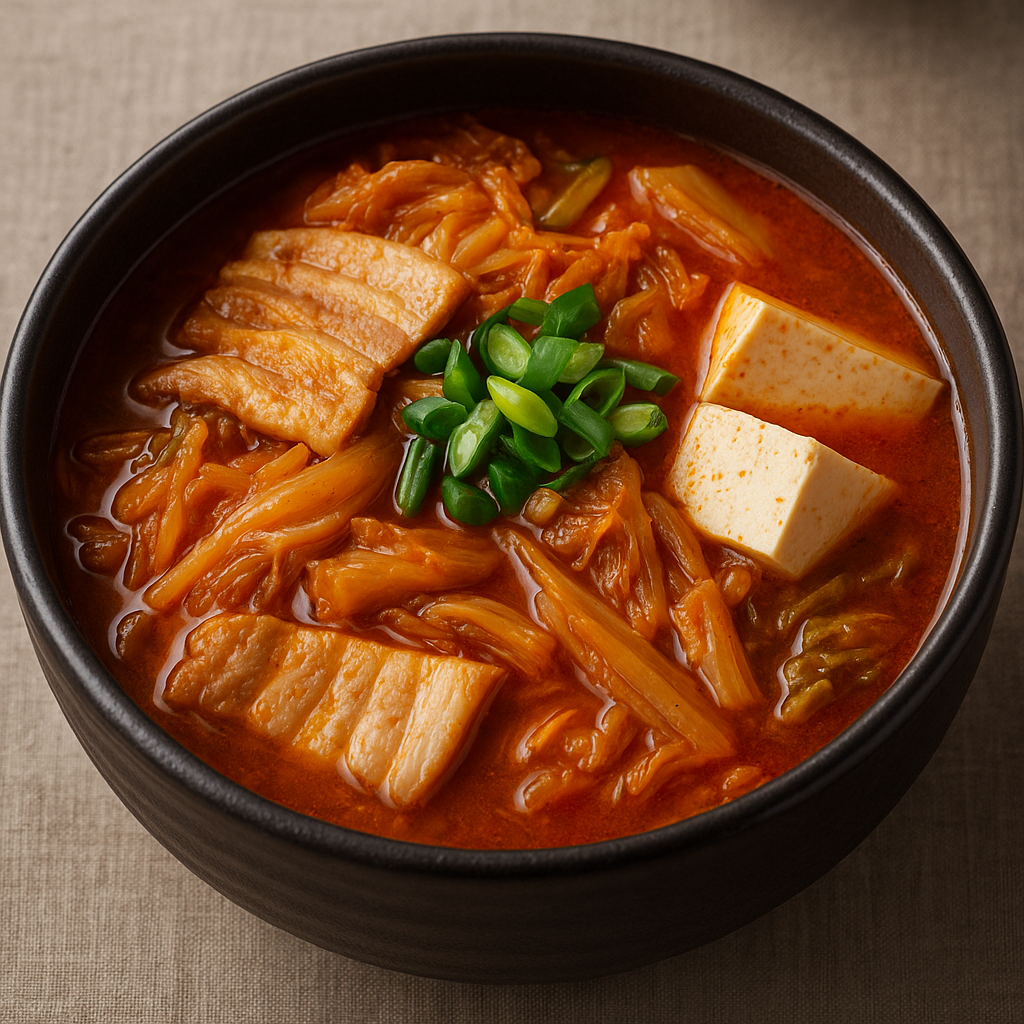Slow-Simmered Kimchi Stew (kimchi jjigae)
Warm, bold, and deeply comforting.

Spicy, bold, and deeply comforting, Kimchi jjigae (김치찌개) is one of Korea’s most beloved everyday dishes — and for good reason. Made with just a few pantry staples, it’s the kind of slow-simmered, soul-warming stew that feels like home in every bite. Whether you’re new to Korean cooking or it’s a longtime comfort classic, this version is rich, cozy, and endlessly satisfying.
- Made with deeply fermented kimchi, tender slices of pork, and silky tofu
- The pork can be marinated ahead of time with gochujang, garlic, and soy sauce for even deeper flavor
- Simmered in a light broth (or water) that transforms into something rich, spicy, and nourishing
- Easy to adapt — swap the meat for mushrooms to make it vegetarian
- Pairs beautifully with a bowl of hot rice and a few simple banchan (side dishes)
- The longer it simmers, the better it gets — and it’s even more flavorful the next day
This is the kind of stew that warms you to the core, fills the kitchen with its bold, savory aroma, and brings everyone to the table. Whether it’s a rainy night or just a moment when you crave something deeply satisfying, Kimchi jjigae always delivers.
Hearty Kimchi Stew (Kimchi Jjigae)
A bold and warming stew made with rich fermented kimchi, tender pork, and silky tofu. Perfect for cozy nights, family meals, or any time you crave a deep, satisfying bowl of comfort.
Ingredients:
- 250g pork belly or any pork cut (or beef brisket, thinly sliced)
- 200g well-fermented kimchi (chopped)
- 5 tbsp kimchi juice (from the kimchi container)
- 2 cups water or broth (optional — water is perfectly fine)
- 1/2 onion, sliced
- 1/2 block firm tofu, cut into thick slices
- 1 tbsp sesame oil
- 1 green onion, chopped (for garnish)
Optional Pork Marinade (Recommended):
- 1 tbsp gochujang (Korean red pepper paste)
- 1 tbsp mirin or cooking wine
- 1/2 tbsp soup soy sauce (Guk-ganjang) — regular soy sauce works in a pinch
- 1 tbsp minced garlic
- Pinch of salt
- Pinch of black pepper
Instructions:
- (Optional) Marinate the Pork:
In a small bowl, combine the pork with gochujang, mirin, soup soy sauce, garlic, salt, and pepper. Let it marinate for at least 30 minutes while prepping other ingredients. - Sauté the Pork and Onion:
Heat sesame oil in a medium pot over medium heat. Add the pork (marinated or plain) and onion. Sauté for about 3–4 minutes until the pork is mostly cooked and the onions are softened. - Add the Kimchi:
Stir in the chopped kimchi and cook for another 3–4 minutes to deepen the flavor. - Simmer the Stew:
Add the water (or broth) and kimchi juice. Bring to a gentle boil, then reduce the heat. Cover and simmer for 20–25 minutes. - Add the Tofu:
Gently nestle in the tofu slices. Simmer uncovered for 5–7 minutes, letting the tofu soak up the broth. - Finish with Green Onion:
Add chopped green onion just before serving, or sprinkle on top as garnish. - Serve:
Serve hot with steamed rice and optional Korean side dishes.
Note on the Rice:
Sometimes a dish is only as comforting as the rice beneath it. For stir-fries, saucy dishes, or anything with bold flavor, I like my rice soft and steady—not too dry, not too sticky. Here's how I usually make it:
How to Make Soft, Fluffy White Rice
- Rinse 1 cup of white rice (short- or medium-grain works well) under cool water until the water runs mostly clear.
- Add to a pot with 1¼ cups water and a pinch of salt, if you like.
- Bring to a gentle boil, then lower the heat, cover, and simmer for 15–18 minutes.
- Turn off the heat and let it sit, covered, for 10 more minutes.
- Fluff with a spoon or rice paddle before serving.
This makes about 2–3 servings. Double or triple it if you're feeding more or want leftovers for tomorrow’s lunch.
If you’d rather keep it simple, you can make the same rice in a rice cooker—just follow the machine’s water line for white rice and let it do the work.
Storage:
- Store in an airtight container in the fridge for up to 3 days
- The flavor gets even better as it sits
- Reheat gently with a splash of water or broth if needed
- Not ideal for freezing — tofu texture may change
Notes:
- Don’t skip the kimchi juice!
The brine left in the kimchi jar is full of fermented flavor that adds real depth to your stew. Just a few tablespoons can completely transform your broth. If your kimchi doesn’t have much juice left, a splash of rice vinegar or a bit of extra broth will help balance the flavor. - Meat Options:
Pork belly is classic, but shoulder, collar, or ribs work well too. Thin slices are best for quick simmering. - Marinating the Meat:
While not traditional, marinating the pork adds rich, savory depth and enhances the overall stew. It’s especially great with leaner cuts. - Vegetarian Option:
Omit the pork and use vegetable broth. Add extra tofu or mushrooms (shiitake, enoki, oyster) to keep it hearty and flavorful. - Kimchi Tip:
Older, sour kimchi is ideal for stew — it brings out a deeper, tangy flavor. Fresh kimchi won’t taste the same. - Water vs. Broth:
Water keeps it clean and classic. Broth gives extra richness, especially if you're using lean meat.
This post contains affiliate links. As an Amazon Associate, I earn from qualifying purchases.
Thank you for being here as I start this journey. I can’t wait to share more recipes, tips, and stories with you — one crumb at a time.
Stay tuned,
~ Clever Crumbs
